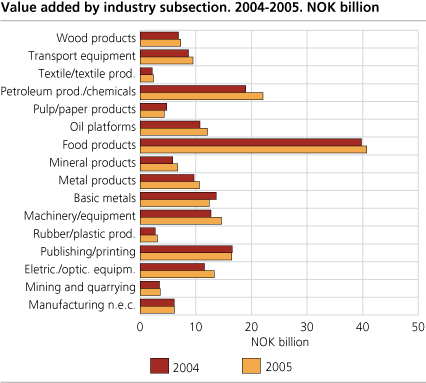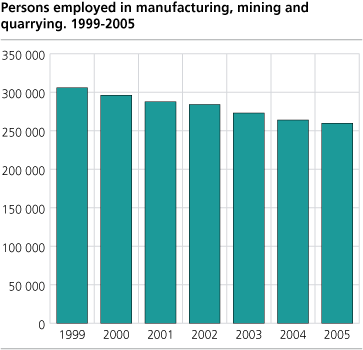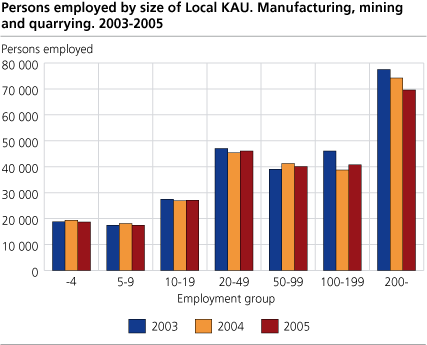Content
Published:
This is an archived release.
Employment up in several industries
Following years of decline in the number of employees, several large manufacturing industries experienced increased employment in 2005. Compared with 2004, value added rose by 6 per cent in 2005. From 2000 to 2005, value added for manufacturing in Norway increased by 25 per cent.
In 2005, value added in manufacturing and mining and quarrying totalled NOK 186 billion. From 2004 valued added increased by NOK 11 billion, or 6 per cent, measured in current prices. The gross value of production totalled NOK 604 billion in 2005. From 2000 to 2005, the production value went up by NOK 103 billion. Most of this growth came from 2003 to 2005.
Increased value added in oil refining and production of chemicals
From 2000 to 2005 the largest growth took place in oil refining and production of chemicals, with an increase in value added of 66 per cent. In 2005, value added totalled NOK 22 billion. Value added in the production of food, beverages and tobacco totalled NOK 41 billion in 2005, but the growth in this industry has come to a halt. Compared with 2004, value added only increased by 2 per cent.
Large industries like production of machinery and equipment and production of oil platforms both experienced a considerable growth in value added by 42 and 34 per cent respectively from 2000 to 2005.
The biggest decline in the period is found for production of pulp and paper. The industry experienced a big fall from 2001 to 2002, and since then value added has remained stable.
Investments up
Gross investment in manufacturing, mining and quarrying totalled NOK 16.7 billion in 2005. This is NOK 1.2 billion higher than in 2004 and NOK 2.4 billion lower than in 2002, which was the top year in the period 2000 to 2005. The development in investments in manufacturing is characterised by large investment projects in the basic metals sector. These investments peaked in 2002, with over NOK 5 billion, but decreased to less than NOK 2 billion in 2005. In 2005, the biggest investments took place in production of basic chemicals.
Employment up in several industries
Manufacturing, mining and quarrying employed 259 658 persons in 2005. This is a decline of more than 4 000 compared with 2004. Various sectors experienced increased employment following years of decline. Production of machinery and equipment saw 800 new persons employed compared with 2004, while employment in production of transport equipment went up by 600. Production of electrical and optical equipment also experienced increased employment. The development in these sectors is related to the growth in new orders in 2005.
Publishing and printing saw a fall in employment of almost 4 000 persons. The background for this is that newspaper deliverers who were previously employed in this sector have been moved to distribution companies outside the manufacturing industry.
Employment in the food, beverages and tobacco industry went down by more than 1 800 from 2004 to 2005. The industry has experienced a decline in employment since 2002. Both the meat and the fish industry follow this development.
From 2000 to 2005,employment in manufacturing and mining and quarrying fell by almost 37 000. Most of the manufacturing sectors saw a decline in employment in this period. The greatest fall came from 2002 to 2004, with more than 20 000.
Tables:
- Table 1 Mining, quarrying and manufacturing. Principal figures for local kind of activity units 1972-2005
- Table 2 Mining, quarrying and manufacturing. Principal figures for local kind of activity units, by industry division. 2000-2005
- Table 3 Mining, quarrying and manufacturing. Persons employed anf value added for local kind of activity units. County. 2000-2005
The statistics is now published as Business statistics.
Contact
-
Statistics Norway's Information Centre
E-mail: informasjon@ssb.no
tel.: (+47) 21 09 46 42



